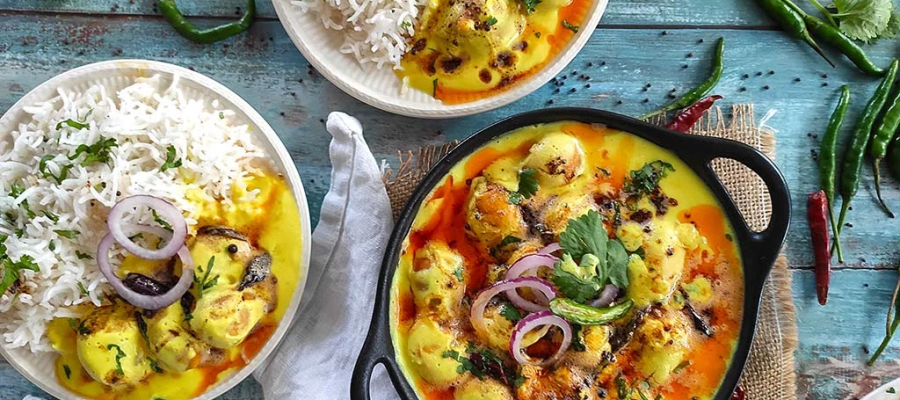Experience the delectable flavors of a cherished family heirloom – a remarkable Kadhi recipe passed down through generations. This delightful Kadhi Pakora, a culinary gem from my mother-in-law, showcases the authentic preparation of Punjabi Kadhi complemented by onion pakoras. Immerse yourself in the goodness of crisp onion fritters immersed in a flavorful, tangy yogurt sauce. This time-honored recipe has been a household favorite, crafted with love and enjoyed by everyone for years.
The term “Kadhi” in Hindi refers to a yogurt-based sauce that undergoes a prolonged cooking process. On the other hand, “pakora” signifies fritters crafted from gram flour (besan). In this particular culinary preparation, the fritters are created using a flavorful and seasoned batter containing onions, gram flour, and various spices.
There are diverse renditions of preparing kadhi in the culinary traditions of North and Western India. While the specific spices or herbs utilized may vary, the common element is the thickening of the yogurt sauce with gram flour, known as besan in Hindi.
Besan is derived from skinned black chickpeas, imparting a nutty flavor to the dish. The yogurt employed in crafting kadhi is typically sour, resulting in a dish with a tangy, spiced, and creamy profile.
Notably, each state and region boasts its own distinctive method of preparing dahi besan kadhi. Varieties include Maharashtrian Kadhi, Rajasthani Kadhi, Gujarati Kadhi, Sindhi Kadhi, and more.
Preparation Time: 1-1.30 hrs
Cooking Time: 30-45 minutes
Cuisine: Vegetarian North Indian / Main Course
Cooking Difficulty: Moderate
Flavor Profile: Tangy & Spicy
How to make Kadhi Pakora:
In this recipe post, I’ve incorporated numerous images for a step-by-step visual guide. Commencing with crafting the curd slurry, followed by preparing the onion pakora, and ultimately, delving into the process of making the flavorful kadhi pakora.
Prepare Curd Slurry
1. Take 1.5 cups of sour curd (approximately 375 grams) in a bowl and whisk it thoroughly until it becomes smooth.
2. Introduce 8 tablespoons of gram flour (besan), ½ teaspoon each of red chilli powder, turmeric powder, and garam masala powder, along with 1 teaspoon of salt to the well-whisked curd.
3. Stir and blend the ingredients thoroughly.
4. Pour in 3 cups of water and mix well.
5. Ensure a lump-free consistency by stirring rigorously. If lumps are present, break them down using a wired whisk, spatula, or your fingers. Set aside the prepared curd slurry.
While a blender can be used, exercise caution not to overblend, as this may result in the formation of butter instead of a smoothly blended curd.
Prepare Pakoras for Kadhi:
1. In a bowl, combine 1 cup of gram flour (besan) with the following ingredients:
– ½ teaspoon ajwain (carom seeds)
– ½ teaspoon red chili powder or cayenne pepper
– ½ teaspoon garam masala powder
– ⅔ teaspoon salt, or as needed
2. Incorporate 1 cup of thinly sliced onions (approximately 150 grams, about 2 medium to large onions).
3. Thoroughly mix the ingredients, cover the bowl, and let it rest for 30 minutes.
4. This allows the onions to release their moisture into the mixture. After 30 minutes, mix again.
5. Adjust the consistency by adding water as needed to achieve a thick batter. I added ¼ cup of water, but you can skip it if the mixture is sufficiently moist.
6. Heat oil for deep frying in a pan or kadai, using any neutral-flavored oil with a high smoking temperature or mustard oil.
7. Once the oil is medium-hot, use a spoon to drop the pakora batter into the oil.
8. When the pakoras are partially cooked, turn them over with a slotted spoon and continue frying the other side.
9. Fry until the pakoras are crisp and golden, turning them over a couple of times for even cooking.
10. Remove the fried pakoras and place them on a kitchen paper towel to absorb excess oil. Fry the pakoras in batches and set them aside when done.
Prepare Kadhi:
1. Heat 2 tablespoons of mustard oil in a large-bottomed pot. If unavailable, you can substitute with any neutral-flavored oil, though traditional Punjabi kadhi typically uses mustard oil. Ensure the pot has enough space to prevent spillage during cooking.
2. Add 1 teaspoon of cumin seeds, 8 to 10 fenugreek seeds (methi seeds), and a generous pinch of asafoetida (hing). Allow the cumin seeds to crackle and the fenugreek seeds to change color. Fry on a low flame to prevent burning.
3. Introduce ⅓ cup of chopped onions, stirring and sautéing for 3 minutes on low to medium-low heat.
4. Add 1 tablespoon of chopped ginger, ¾ to 1 tablespoon of chopped garlic, and 2 chopped green chilies. Stir and sauté for an additional minute.
5. Include 8 to 10 curry leaves and 2 dry red chilies (halved or broken). Stir and sauté for another minute on low heat.
6. Integrate the curd slurry into the mixture.
7. Stir thoroughly.
8. Increase the flame to medium, bringing the kadhi to a boil. Stir consistently to prevent browning at the bottom. Cooking time for the kadhi is approximately 14 to 16 minutes.
9. Once boiling, reduce the heat and let it simmer for an additional 6 to 7 minutes. Stir occasionally.
10. As the kadhi cooks and simmers, it will thicken. If it becomes too thick, add some hot water to achieve the desired consistency.
Prepare Kadhi Pakora:
1. Introduce the onion pakora into the kadhi and gently blend.
2. Cover with a lid, allowing the onion pakora to absorb the flavors for 8 to 10 minutes.
3. Finally, dust Punjabi Kadhi with a sprinkle of garam masala powder.
4. Enhance the presentation by garnishing with coriander leaves. Serve the hot Punjabi Kadhi Pakora over steamed rice or jeera rice, generously topped with a few spoonfuls of ghee.
Alternatively, pair it with roti or paratha. However, the widely acclaimed and delightful combination of Kadhi Chawal (kadhi served with steamed rice) is a popular choice.
Tips by Chef Mrs Kohli
Yogurt: Opt for full-fat sour curd or sour yogurt made from whole milk. If the curd lacks sourness, the kadhi will still taste good, though not tangy. To impart sourness, allow the set curd to sit at room temperature for a few hours. Alternatively, add ½ to 1 teaspoon of amchur powder (dry mango powder) or a splash of lemon juice after cooking.
Fats: Ideally, use mustard oil for frying onion pakoras and for tempering to infuse a pungent, sharp taste. If mustard oil is unavailable, substitute it with a neutral oil like sunflower oil.
Baking Pakoras: For a healthier alternative, consider baking the pakoras instead of deep-frying. Preheat the oven to 180 degrees Celsius and bake until the pakoras turn crisp and golden. When baking, incorporate 1 to 2 tablespoons of oil in the batter, ensuring it’s slightly wet but not overly moist.
Curry Leaves: Do not omit curry leaves, as they contribute essential flavor to the kadhi pakora. If unavailable, you may skip them.
Gram Flour: Choose high-quality gram flour (besan) for the best results. Chickpea flour can be a substitute in a pinch.
Preparation: Prepare the onion pakoras in advance and set them aside.
Cooking Kadhi: Use a large-bottomed pot to avoid spillage, as the kadhi froths during cooking.
Pakora Texture: Adjust the water quantity for softer pakoras, adding more than specified in the recipe. Introduce the pakoras into the kadhi just before serving to prevent them from becoming overly soft. If a firmer texture is preferred, add minimal water to the batter.
In this particular recipe, the pakoras are not intentionally softened. Incorporate just enough water to achieve a smooth but not runny batter. Consequently, you can add the pakoras right after preparing the kadhi without fear of them breaking when served later.


